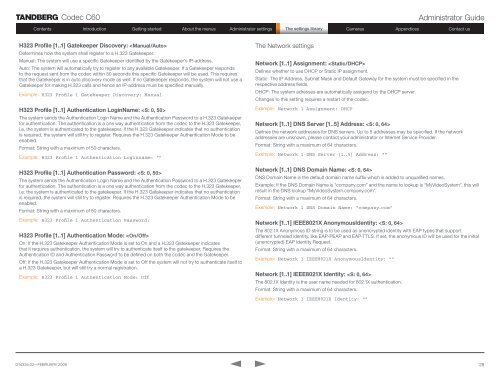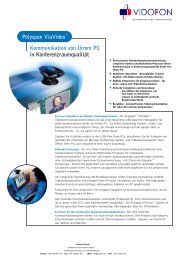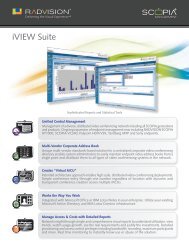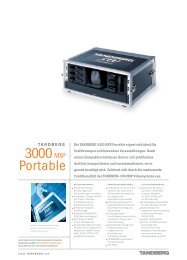Cisco (Tandberg) Codec C60 Admin Guide - Vidofon
Cisco (Tandberg) Codec C60 Admin Guide - Vidofon
Cisco (Tandberg) Codec C60 Admin Guide - Vidofon
You also want an ePaper? Increase the reach of your titles
YUMPU automatically turns print PDFs into web optimized ePapers that Google loves.
<strong>Codec</strong> <strong>C60</strong> <strong>Admin</strong>istrator <strong>Guide</strong><br />
Contents Introduction Getting started About the menus <strong>Admin</strong>istrator settings The Settings settings Library library<br />
Cameras Appendices Contact us<br />
H323 Profile [1..1] Gatekeeper Discovery: <br />
Determines how the system shall register to a H.323 Gatekeeper.<br />
Manual: The system will use a specific Gatekeeper identified by the Gatekeeper’s IP-address.<br />
Auto: The system will automatically try to register to any available Gatekeeper. If a Gatekeeper responds<br />
to the request sent from the codec within 30 seconds this specific Gatekeeper will be used. This requires<br />
that the Gatekeeper is in auto discovery mode as well. If no Gatekeeper responds, the system will not use a<br />
Gatekeeper for making H.323 calls and hence an IP-address must be specified manually.<br />
Example: H323 Profile 1 Gatekeeper Discovery: Manual<br />
H323 Profile [1..1] Authentication LoginName: <br />
The system sends the Authentication Login Name and the Authentication Password to a H.323 Gatekeeper<br />
for authentication. The authentication is a one way authentication from the codec to the H.323 Gatekeeper,<br />
i.e. the system is authenticated to the gatekeeper. If the H.323 Gatekeeper indicates that no authentication<br />
is required, the system will still try to register. Requires the H.323 Gatekeeper Authentication Mode to be<br />
enabled.<br />
Format: String with a maximum of 50 characters.<br />
Example: H323 Profile 1 Authentication Loginname: “”<br />
H323 Profile [1..1] Authentication Password: <br />
The system sends the Authentication Login Name and the Authentication Password to a H.323 Gatekeeper<br />
for authentication. The authentication is a one way authentication from the codec to the H.323 Gatekeeper,<br />
i.e. the system is authenticated to the gatekeeper. If the H.323 Gatekeeper indicates that no authentication<br />
is required, the system will still try to register. Requires the H.323 Gatekeeper Authentication Mode to be<br />
enabled.<br />
Format: String with a maximum of 50 characters.<br />
Example: H323 Profile 1 Authentication Password:<br />
H323 Profile [1..1] Authentication Mode: <br />
On: If the H.323 Gatekeeper Authentication Mode is set to On and a H.323 Gatekeeper indicates<br />
that it requires authentication, the system will try to authenticate itself to the gatekeeper. Requires the<br />
Authentication ID and Authentication Password to be defined on both the codec and the Gatekeeper.<br />
Off: If the H.323 Gatekeeper Authentication Mode is set to Off the system will not try to authenticate itself to<br />
a H.323 Gatekeeper, but will still try a normal registration.<br />
Example: H323 Profile 1 Authentication Mode: Off<br />
The Network settings<br />
Network [1..1] Assignment: <br />
Defines whether to use DHCP or Static IP assignment.<br />
Static: The IP Address, Subnet Mask and Default Gateway for the system must be specified in the<br />
respective address fields.<br />
DHCP: The system adresses are automatically assigend by the DHCP server.<br />
Changes to this setting requires a restart of the codec.<br />
Example: Network 1 Assignment: DHCP<br />
Network [1..1] DNS Server [1..5] Address: <br />
Defines the network addresses for DNS servers. Up to 5 addresses may be specified. If the network<br />
addresses are unknown, please contact your administrator or Internet Service Provider.<br />
Format: String with a maximum of 64 characters.<br />
Example: Network 1 DNS Server [1..5] Address: “”<br />
Network [1..1] DNS Domain Name: <br />
DNS Domain Name is the default domain name suffix which is added to unqualified names.<br />
Example: If the DNS Domain Name is “company.com” and the name to lookup is “MyVideoSystem”, this will<br />
result in the DNS lookup “MyVideoSystem.company.com”.<br />
Format: String with a maximum of 64 characters.<br />
Example: Network 1 DNS Domain Name: “company.com”<br />
Network [1..1] IEEE8021X AnonymousIdentity: <br />
The 802.1X Anonymous ID string is to be used as unencrypted identity with EAP types that support<br />
different tunneled identity, like EAP-PEAP and EAP-TTLS. If set, the anonymous ID will be used for the initial<br />
(unencrypted) EAP Identity Request.<br />
Format: String with a maximum of 64 characters.<br />
Example: Network 1 IEEE8021X AnonymousIdentity: “”<br />
Network [1..1] IEEE8021X Identity: <br />
The 802.1X Identity is the user name needed for 802.1X authentication.<br />
Format: String with a maximum of 64 characters.<br />
Example: Network 1 IEEE8021X Identity: “”<br />
D14334.02—FEBRUARY 2009 28








